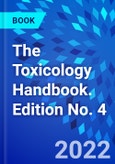The book has been streamlined and fully updated to provide a comprehensive yet concise guide for all medical practitioners and health-care professionals who deal with poisonings. It contains quickly accessible information on poisons, toxins, antidotes, envenomings and antivenoms, and uses a structured and rigorous risk assessment-based approach to guide appropriate treatment decisions.
Written by leading Australian specialists in toxicology and informed by the latest clinical research, this is a must-have addition to all emergency departments and poison information centres.
- Concisely written: helps the student, trainee, and clinician to find information quickly and easily - A simple, easily remembered and elegant framework (R RSI DEAD) forming the basis of care for all toxicology patients - Fully revised content, streamlined to be more user-friendly - Evidence based and up to date - supports appropriate decision making - Helps resolve common treatment dilemmas, including for digoxin and lithium poisoning, corrosive ingestions and management of envenomings - Written and edited by experts in the field of toxicology - An eBook included in all print purchases - Expanded information on agents that are seen with increasing frequency in poisoned patients, including lamotrigine and pregabalin - Updated detail on the management of agents including direct oral anticoagulants, digoxin, desvenlafaxine and corrosives - Updated and standardised treatment recommendations for dysrhythmias, particularly resulting from drug-induced conduction abnormalities (QRS and QT prolongation) - Simplified and standardised approaches to management (particularly cardiovascular toxicity from a variety of agents)
Table of Contents
CHAPTER 1 APPROACH TO THE POISONED PATIENT
1.1�Overview
1.2�Resuscitation
1.3�Risk assessment
1.4�Supportive care and monitoring
1.5�Investigations
1.6�Gastrointestinal decontamination
1.7�Enhanced elimination
1.8�Antidotes
1.9�Description
CHAPTER 2 SPECIFIC CONSIDERATIONS
2.1�Coma
2.2�Hypotension
2.3�Seizures
2.4�Approach to delirium
2.5�Serotonin toxicity
2.6�Anticholinergic toxicity
2.7�Cholinergic toxicity
2.8�Neuroleptic malignant syndrome
2.9�Alcohol use disorder
2.10�Amphetamine use disorder�
2.11�Opioid use disorder
2.12�Sedative-hypnotic use disorder
2.13�Solvent abuse
2.14�Body packers and stuffers
2.15�Osmolar gap
2.16�Acid-base disorders�
2.17�The 12-lead ECG in toxicology
2.18�Approach to mushroom poisoning
2.19�Approach to plant poisoning
2.20�Poisoning during pregnancy and lactation
2.21�Poisoning in children
2.22�Poisoning in the elderly
CHAPTER 3 SPECIFIC TOXINS
3.1�Alcohol: Ethanol
3.2�Alcohol: Ethylene glycol
3.3�Alcohol: Isopropanol (isopropyl alcohol)
3.4�Alcohol: Methanol (methyl alcohol)
3.5�Alcohol: Other toxic alcohols
3.6�Amisulpride
3.7�Amphetamines and amphetamine-like substances
3.8�Angiotensin-converting enzyme inhibitors (ACEIs) and angiotensin II receptor blockers (ARBs)
3.9�Anticoagulant rodenticides
3.10�Anticonvulsants: Newer agents
3.11�Antihistamines (non-sedating)
3.12�Antihistamines (sedating)
3.13�Arsenic
3.14�Baclofen
3.15�Barbiturates
3.16�Benzodiazepines
3.17�Benztropine
3.18�Beta-blockers
3.19�Bupropion
3.20�Button batteries
3.21�Calcium channel blockers (CCBs)
3.22�Cannabinoids and synthetic cannabinoid receptor agonists (SCRAs)
3.23�Carbamazepine
3.24�Carbon monoxide
3.25�Chloroquine and hydroxychloroquine
3.26�Chloral hydrate
3.27�Clonidine and other central ?2-adrenergic agonists
3.28�Clozapine
3.29�Cocaine
3.30�Colchicine
3.31�Corrosives
3.32�Cyanide
3.33�Digoxin: Acute overdose
3.34�Digoxin: Chronic poisoning
3.35�Diphenoxylate-atropine
3.36�Direct oral anticoagulants
3.37�Gamma-hydroxybutyrate (GHB)
3.38�Glyphosate
3.39�Hydrocarbons
3.40�Hydrofluoric acid
3.41�Hydrogen peroxide
3.42�Insulin
3.43�Iron
3.44�Isoniazid
3.45�Lamotrigine
3.46�Lead
3.47�Lithium: Acute overdose
3.48�Lithium: Chronic poisoning
3.49�Local anaesthetic agents
3.50�Mercury
3.51�Metformin
3.52�Methotrexate
3.53�Mirtazapine
3.54�Monoamine oxidase inhibitors (MAOIs)
3.55�Non-steroidal anti-inflammatory drugs (NSAIDs)
3.56�Olanzapine
3.57�Opioids
3.58�Organochlorines
3.59�Organophosphorus agents (organophosphates and carbamates)
3.60�Paracetamol: Immediate-release preparations (acute overdose)
3.61�Paracetamol: Modified-release formulations
3.62�Paracetamol: Repeated supratherapeutic ingestion
3.63�Paraquat
3.64�Phenothiazines and butyrophenones (antipsychotic agents)
3.65�Phenytoin
3.66�Potassium chloride
3.67�Pregabalin
3.68�Quetiapine�
3.69�Quinine
3.70�Risperidone
3.71�Salicylates
3.72�Selective serotonin reuptake inhibitors (SSRIs)
3.73�Strychnine
3.74�Sulfonylureas
3.75�Theophylline
3.76�Thyroxine
3.77�Tramadol and tapentadol
3.78�Tricyclic antidepressants (TCAs)
3.79�Valproic acid (sodium valproate)�
3.80�Venlafaxine and desvenlafaxine
3.81�Warfarin
CHAPTER 4 ANTIDOTES
4.1�Atropine
4.2�Calcium
4.3�Cyproheptadine
4.4�Desferrioxamine
4.5�Digoxin immune fab
4.6�Dimercaprol
4.7�DMSA (succimer) and DMPS (unithiol)
4.8�Ethanol
4.9�Flumazenil
4.10�Folinic acid
4.11�Fomepizole
4.12�Glucose
4.13�Hydroxocobalamin
4.14�Insulin (high-dose)
4.15�Intravenous lipid emulsion
4.16�Methylene blue
4.17�N-acetylcysteine
4.18�Naloxone�
4.19�Octreotide
4.20�Penicillamine
4.21�Physostigmine
4.22�Pralidoxime
4.23�Pyridoxine
4.24�Sodium bicarbonate
4.25�Sodium calcium edetate
4.26�Sodium thiosulfate
4.27�Vitamin K
CHAPTER 5 ENVENOMINGS
5.1�Approach to snakebite
5.2�Black snake
5.3�Brown snake
5.4�Death adder
5.5�Tiger snake group
5.6�Taipan
5.7�Sea snakes
5.8�Australian scorpions
5.9�Bluebottle jellyfish (Physalia species)
5.10�Stonefish
5.11�Box jellyfish
5.12�Irukandji syndrome
5.13�Blue-ringed octopus
5.14�Redback spider
5.15�Funnel-web (big black) spider
5.16�White-tailed spider
5.17�Ticks
CHAPTER 6 ANTIVENOMS
6.1�Black Snake Antivenom
6.2�Brown Snake Antivenom
6.3�Death Adder Antivenom
6.4�Tiger Snake Antivenom
6.5�Taipan Antivenom
6.6�Sea Snake Antivenom
6.7�Polyvalent Snake Antivenom
6.8�Stonefish Antivenom
6.9�Box Jellyfish Antivenom
6.10�Redback Spider Antivenom
6.11�Funnel-Web Spider Antivenom
6.12��� Allergic Reactions to Antivenom








